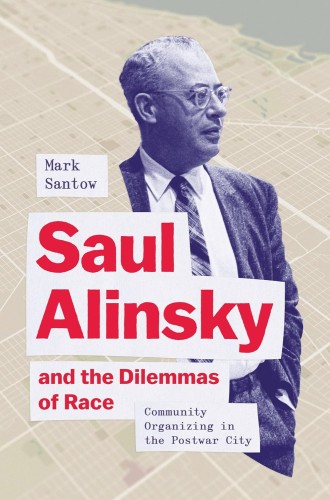The strengths and limitations of Saul Alinsky’s approach
Mark Santow’s intellectual biography of the influential organizer explores how his Chicago coalitions wrestled with the challenges of race.

Saul Alinsky and the Dilemmas of Race
Community Organizing in the Postwar City
I cut my teeth in Saul Alinsky–style organizing with COPS/Metro Alliance, a San Antonio affiliate of the Industrial Areas Foundation, which Alinsky founded in Chicago in 1939. IAF fosters a form of broad-based institutional organizing that works by creating community-based alliances to advocate for social, political, racial, and economic justice. Schools, PTAs, churches, synagogues, mosques, labor unions, and other groups join the affiliate organization in order to build political and economic power for working people’s communities.
When I first started, longtime COPS leaders shared stories about the floods that would ravage the west side of town in the 1970s. In the neighborhoods where Latinx immigrants predominantly lived, rainwater often swept through the streets, rising up through doors, seeping into walls, and filling houses. People told me they had memories of clearing out sludge from their ovens. Cars were swept away, and occasionally, children. The richer, Whiter parts of town had the infrastructure that the West Side lacked: not only proper drainage systems but also decent parks, grocery stores, and banks—social and economic institutions essential for a community’s health and stability.
Read our latest issue or browse back issues.
Similar stories of racial segregation and economic extraction can be told about cities across the country. In midcentury Chicago, such stories plagued Black neighborhoods, as Mark Santow explores in his new book. Santow shows how Alinsky and the organizations he helped found built political and economic power to confront deep inequalities rooted in the social geography of race—the relationship between race, place, and property. Where you live, what public and health services you have access to, what kinds of jobs are open and available to you, what sort of power you have at the workplace, how safe and stable your schools and housing are, and what your racial identity is: these factors are all related.
Alinsky was organizing during two historic moments in national politics: in the 1940s and the 1960s, when change in housing and schooling policy was conceivably possible. But for reasons that Santow makes clear—partly due to Alinsky’s organizing strategy, partly due to intransigence of White communities and their political representatives at federal and local levels—both of these opportunities were missed. Today, we may yet have a third opportunity. Santow argues that with the rise of Black Lives Matter and then the Biden presidency, structural change to desegregate housing and schools just might be possible. But taking advantage of such an opportunity requires organizing efforts that grasp the federal nature of local politics. This is something that Alinsky and his organizations in Chicago had to learn the hard way.
Saul Alinksy and the Dilemmas of Race is more than an intellectual biography of Alinsky, though it certainly is that. The book is also a fascinating and detailed exploration of how Alinsky and his Chicago organizations wrestled with the challenges of race in their organizing strategy. This conversation is significant because Alinsky-style organizing has long been criticized as failing to grasp how deeply this country’s politics and economy are shaped by race. Although Alinsky explicitly organized around racial injustice in Chicago, Santow argues that Alinsky’s organizing strategy fails to contend with the social geography of racial politics. Race is embedded in our neighborhoods, our housing markets, the lending practices of banks, and our school systems. “People don’t experience racial hierarchy in general,” Santow writes, “they experience it in particular places at particular times. What power is, and how it is experienced and cognitively understood, is tied to how it finds its way into the built environment, where people live, and how they think of property, community, and social belonging.”
Santow’s central point is this: Alinsky provided one important, albeit fraught, example of building democratic power to contend with the social geography of race—and his model is instructive for today’s racial and economic justice fights.
In different ways and for different reasons, each of the Alinsky-related organizations Santow examines—the Back of the Yards Neighborhood Council, the Organization for the Southwest Community, and the Woodlawn Organization—failed to adequately confront housing and school segregation at the metropolitan and federal levels. Santow shows that “grassroots activism wasn’t enough; economic growth wasn’t enough; antidiscrimination law wasn’t enough; a revamped welfare state wasn’t enough. Untying the Gordian knot of race in America required an alchemical mixture of all at once.” Because of the social geography of race and the reality that neighborhood desegregation has to be approached at a metropolitan level and not merely a neighborhood one, the local organizing strategies adopted by BYNC, OSC, and TWO fell short.
BYNC and OSC saw their members retreat from integrative efforts and instead adopt conservative ones. These White neighborhoods eventually sought to keep Black people out by setting up, supporting, or simply ignoring racist housing and lending practices. TWO, an IAF organization in a predominantly Black neighborhood that had been systematically oppressed, saw its own programs in workforce and community development become ensnared in the power politics and national influence of Mayor Richard J. Daley.
This is not to deny the important differences that organizations like BYNC, OSC, and especially TWO made in their neighborhoods. Despite their shortcomings, these organizations built real economic and political power in their communities. But at nearly every turn, the organizations’ power did not ripple out. OSC found, for instance, that if you attempt to integrate one neighborhood, there will be White flight into a different segregated community. And that investing in economically exploited communities will just shove the residents to other segregated and exploited neighborhoods.
Santow’s point is that Alinsky’s strategy of organizing communities around territorial identity cannot meet the larger structural nature of local issues. Undoing the nefarious relationship between race, place, and property requires a strategy that transcends the identity of place.
When I was organizing in San Antonio, I learned that COPS had successfully built its base by appealing to people’s sense of territorial identity: “This is our home and we deserve better!” There were successes, but Santow’s book raises important questions about this strategy. In a gig economy with increasing levels of remote work, our communities, neighborhoods, and workplaces look starkly different from Alinsky’s Chicago. Territorial identity may no longer be an effective, or at least the only effective, organizing strategy.
But Santow goes further: perhaps it never was. Housing and schooling segregation have always been issues that need to be resolved at the city and federal level. Building political and economic power cannot stay isolated in single communities or neighborhoods; it must creatively expand across neighborhood, economic, and political boundaries.





